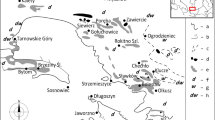Abstract
In the present work the characterization of six ingots of ancient Roman Lead, found on the seabed near Mal Di Ventre Isle (Sardinia-Italy), is presented. The ingots come from three different foundries, defined by following codes found on the particular ingots selves: SOCPONTILIENORUMMF, QAPPCF and MCPONTILIENORUMMF. The foundries were active about 2000 years ago in Sierra de Cartagena (Spain) where some of the most important lead mines of the Roman Empire were located. In order to identify the provenance of the ingots and to shed some lights on their manufacturing we applied a multi-analytical method, based on instrumental neutron activation analysis and thermal ionization mass spectrometry. Coupling the two techniques it was possible to obtain an accurate multi-elemental and isotopical fingerprint of the different ingots, giving some important results in the field of archeo-metallurgy. The possibility to perform such measurements with a non-destructive approach satisfies a very important request of the cultural heritage authorities involved in the protection and conservation of similar goods.





Similar content being viewed by others
References
Wilson AL (1978) Elemental analysis of pottery in the study of its provenance: a review. J Archeol Sci 5:219–236
Hughes RE, Smith RL (1993) Archaeology, geology, and geochemistry in obsidian provenance studies. Geol S Am S 283:79–91
Bishop RL, Blackman MJ (2002) Instrumental neutron activation analysis of archaeological ceramics: scale and interpretation. Acc Chem Res 35:603–610
Bellot-Gurlet L, Poupeau G, Salomon J, Calligaro T, Moignard B, Dran JC, Barrat JA, Pichon L (2003) Obsidian provenance studies in archaeology: a comparison between PIXE, ICP-AES and ICP-MS. Nucl Instrum Methods B 240:583–588
Tite MS (2008) Ceramic production, provenance and use—a review. Archaeometry 50:216–231
Shackley MS (2010) An Introduction to X-Ray Fluorescence (XRF) Analysis in Archaeology. In: X-Ray fluorescence spectrometry (XRF) in geoarchaeology, Springer, Berlin
Brill RH, Wampler JR (1967) Isotope studies of ancient lead. Am J Archaeol 71:63–77
Rehren TH, Pernicka E (2008) Coins, artefacts and isotopes–archaeometallurgy and archaeometry. Archaeometry 50:232–248
Trincherini PR, Domergue C, Manteca I, Nesta A, Quarati P (2009) The identification of lead ingots from the Roman mines of Cartagena: the role of lead isotope analysis. J Roman Archaeol 22:123–145
Balcaen L, Moens L, Vanhaecke F (2010) Determination of isotope ratios of metals (and metalloids) by means of inductively coupled plasma-mass spectrometry for provenancing purposes—a review. Spectrochim Acta B 65:769–786
Nehlich O (2015) The application of sulphur isotope analyses in archaeological research: a review. Earth Sci Rev 142:1–17
Glascock MD, Neff H (2003) Neutron activation analysis and provenance research in archaeology. Meas Sci Technol 14:1516
Glascock MD, Neff H, Vaughn KJ (2004) Instrumental neutron activation analysis and multivariate statistics for pottery provenance. Hyperfine Interact 154:95–105
Speakman RJ, Glascock MD (2007) Acknowledging fifty years of neutron activation analysis in archaeology. Archaeometry 49:179–183
Klein S, Lahaye Y, Brey JP, Von Kaenel HM (2004) The early Roman imperial AES coinage II: tracing the copper sources by analysis of lead and copper isotopes-copper coins of Augustus and Tiberius. Archaeometry 46:469–480
Durali-Mueller S, Brey GP, Wigg-Wolf D, Lahaye Y (2007) Roman lead mining in Germany: its origin and development through time deduced from lead isotope provenance studies. J Archaeol Sci 24:2093–2101
Stos-Gale Z, Gale NH, Houghton J, Speakman R (1995) Lead isotope data from the isotrace laboratory, Oxford: archaeometry data base 1, ores from the western Mediterranean. Archaeometry 37:407–415
Trincherini PR, Barbero P, Quarati P, Domergue C, Long L (2001) Where do the lead ingots of the saintes-maries-de-la-mer wreck come from? Archaeology compared with physics. Archaeometry 43:393–406
Domergue C, Quarati P, Nesta A, Obejero G, Trincherini PR (2013) Lead isotopes and the identification of the Roman lead ingots from the Sierra Morena mines. Pallas 90:243–256
Akishin P, Nikitin O, Panchenkov G (1957) A new effective ionic emitter for the isotopic analysis of lead. Geochemistry 5:500–505
Borio di Tigliole A, Cammi A, Chiesa D, Clemenza M, Manera S, Nastasi M, Pattavina L, Ponciroli R, Pozzi S, Prata M, Previtali E, Salvini A, Sisti M (2014) TRIGA reactor absolute neutron flux measurement using activated isotopes. Prog Nucl Energ 70:249–255
Clemenza M, Fiorini E, Previtali E, Sala E (2012) Measurement of airborne 131I, 134Cs and 137Cs due to the Fukushima reactor incident in Milan (Italy). J Environ Radioact 114:113–118
Baccolo G, Clemenza M, Delmonte B, Maffezzoli N, Nastasi M, Previtali E, Maggi V (2015) Assesing the geochemical fingerprint of the 2010 Eyjafjallajokull tephra through instrumental neutron activation analysis: a trace element approach. J Radioanal Nucl Chem 306:429–435
Baccolo G, Clemenza M, Delmonte B, Maffezzoli N, Nastasi M, Previtali E, Maggi V (2016) A new method based on Low Background Instrumental Neutron Activation Analysis for major, trace and ultra-trace elements determination in atmospheric mineral dust from polar ice cores. Anal Chim Acta 922:11–18
Jones GDB (1980) The Roman mines at Riotinto. J Roman Stud 70:146–165
Butcher K, Ponting M, Chandler G (1997) A study of the chemical composition of Roman silver coinage, A.D. 196-197. Am J Numis 9:17–36
Acknowledgments
We would like to thank all the LENA staff for their precious support during irradiations.
Author information
Authors and Affiliations
Corresponding author
Rights and permissions
About this article
Cite this article
Clemenza, M., Contini, A., Baccolo, G. et al. Development of a multi-analytical approach for the characterization of ancient Roman lead ingots. J Radioanal Nucl Chem 311, 1495–1501 (2017). https://doi.org/10.1007/s10967-016-5040-x
Received:
Published:
Issue Date:
DOI: https://doi.org/10.1007/s10967-016-5040-x




